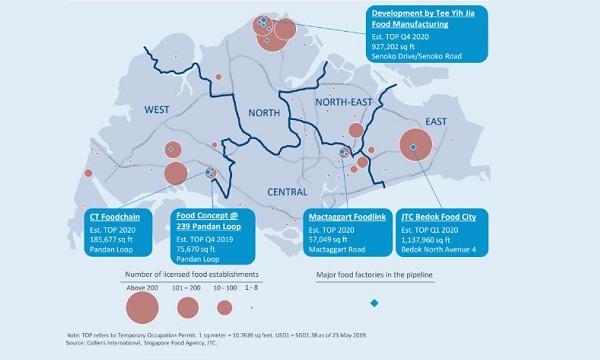
Food factories are eating up Singapore's industrial space
Over 630,000 sqft of food factory space came on-stream in 2019 YTD.
The rising popularity of food delivery firms like Deliveroo, GrabFood and foodpanda is driving the steady growth of facilities designed to store, process, cook and package food in Singapore with another 3.68 million sq ft of food factory space in the pipeline, according to property consulting firm Colliers.
Of this number, over 80% is scheduled for completion in 2019-2020 especially in the North, East and West regions. Prominent projects include JTC Bedok Food City, which has a total Gross Floor Area of more than one million sq ft and is slated for completion in early 2020. An integrated Halal Food Hub in the West region that spans 600,000 sqft that was proposed by Elite Partners Capital and the Singapore Malay Chamber of Commerce and Industry in May 2019 as part of efforts to enhance Singapore’s halal industry, is also expected to be ready in two years. The project costs around $80m-100m.
A total of 637,115 sq ft of food factory space, equivalent to 1-2% of current food factory stock, came on-stream in 2019 YTD, a massive increase from the 31,431 sq ft that was completed in the full-year of 2018, according to data from JTC which was cited by Colliers. In March 2018, Foodpanda unveiled its first central kitchen with a dine-in option in Woodlands Industrial Xchange and Deliveroo launched its second central kitchen in CT Hub 2 which offers a pick-up option in April.
“We expect demand to lag behind supply in 2019-2020 but still remain sustained driven by rising popularity of food delivery services and e-commerce, the need of F&B operators to streamline their retail spaces as well as the government’s push for greater productivity and innovation in Singapore’s food industry,” Tricia Song, head of research at Colliers International said in a statement.
Also read: Foodtech slowly devours startup funding in Singapore
Located mostly in North and West regions and typically within various JTC Food Zones, food factories range from as little as 3,000 sq ft in older premises and up to 40,000 sq ft in new buildings.
Song observed that food factories nearer mature food manufacturing areas such as MacPherson, Pandan Loop and Bedok North are able to maintain high occupancy rates between 80-10% although factories in newer and further locations like Tuas and Senoko tend to have lower occupancies of around 60%.
“We recommend that occupiers be mindful of the regulations and keep an open mind to facilities further from the city centre in view of rent savings,” Song said. “Operators should continue to upgrade their facilities to remain competitive”
























 Advertise
Advertise









